环境:window10 + python3
一、安装NLTK
pip install nltk# 或者 PyCharm --> File --> Settings --> Project Interpreter --> +号搜索 --> Install Package 【matplotlib、numpy、pandas一并安装,后面会用到】
二、下载NLTK books数据
# download_books.py 中# -*- coding: utf-8 -*-# Nolaimport nltknltk.download()


特别说明:Download Directory(下载目录)可以自己指定,父目录必须为nltk_data,此处下载目录为沙盒环境下的share目录。若不知道该怎么自定义下载目录可参考下方提供的几个查找目录,放在查找目录下一定没错:
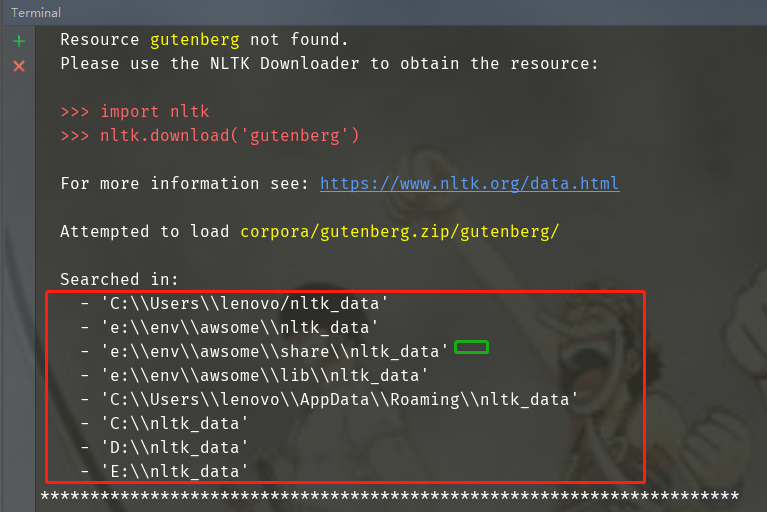
若显示下载失败,在NLTK Downloader界面的All Packages找到对应的库单独下载。
三、使用NLTK books数据
1.1 引入books数据集
# Pycharm 打开Terminal# 安装ipythonpip install ipythonfrom nltk.book import *text1text2
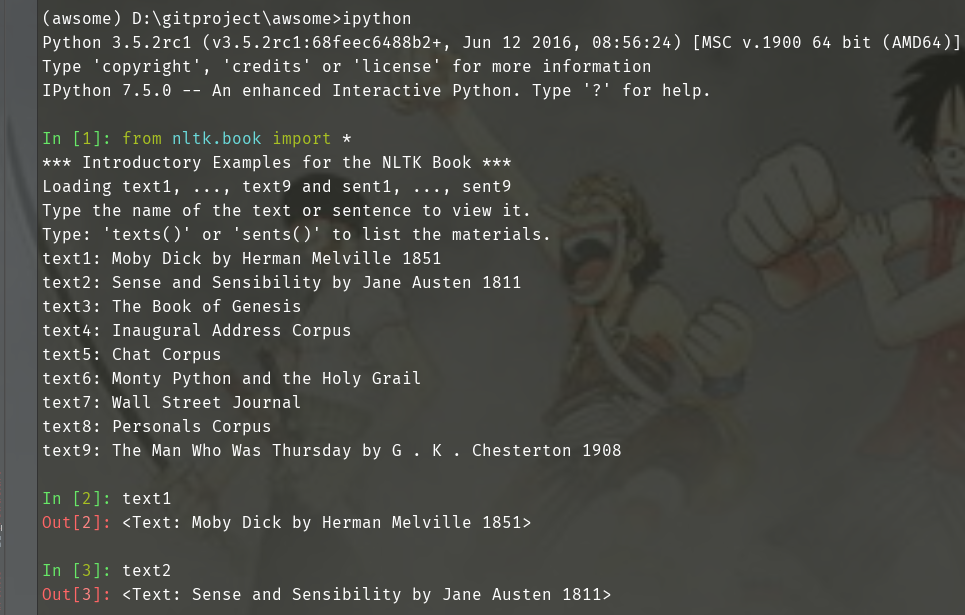
1.2 搜索文本
# concordance(word)函数 词汇索引word及上下文text1.concordance("monstrous")text2.concordance("affection")text5.concordance("lol")# similar(word)函数 搜索word相关词text1.similar("monstrous")text2.similar("monstrous")# common_contexts([word1, word2])函数 搜索多个word共同上下文text2.common_contexts(["monstrous", "very"])# dispersion_plot([word1, word2, word3])函数 判断词在文本中的位置(每一竖线代表一个单词,从文本开始位置到指定词前面有多少给词) 离散图(使用matplotlib画图) 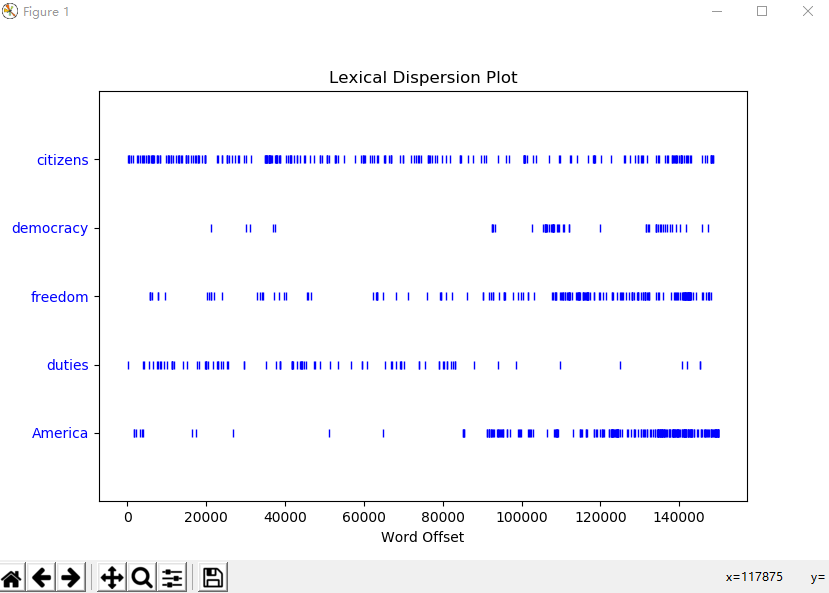
# generate() 生成随机文本text3.generate()

1.3 词汇计数
# python语法len(text3)sorted(set(text3))len(set(text3))
1.4 词频分布
# FreqDist(text)函数 返回text文本中每个词出现的次数的元组列表fdist1 = FreqDist(text1)fdist1FreqDist({ ',': 18713, 'the': 13721, '.': 6862, 'of': 6536, 'and': 6024, 'a': 4569, 'to': 4542, ';': 4072, 'in': 3916, 'that': 2982, ...})print(fdist1) # hapaxes()函数 返回低频词len(fdist1.hapaxes()) # most_common(num)函数 返回高频词汇top50fdist1.most_common(50)fdist1.plot(50, cumulative=True) # top50词汇累计频率图 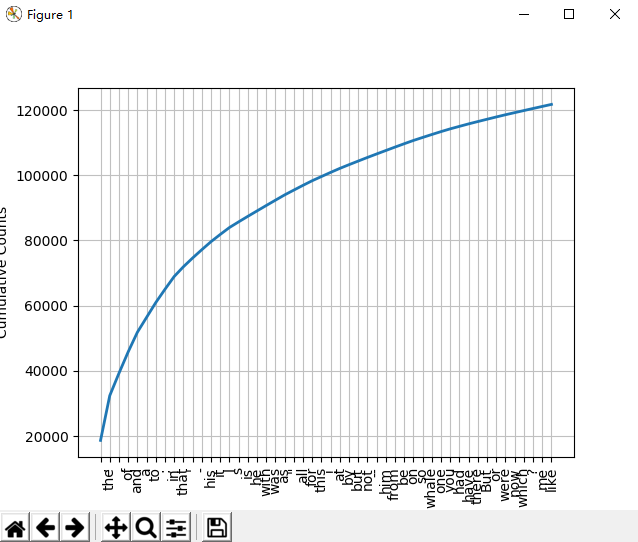
1.5 细粒度选择词
高频词和低频词提取出的信息量有限,研究文本中的长词提取出更多的信息量。采用集合论的一些符号:P性质,V词汇,w单个词符,P(w)当且仅当w词符长度大于15。表示为:{w | w ∈ V & P(w)}
V = set(text1)long_words = [w for w in V if len(w) > 15]len(long_words)fdist5 = FreqDist(text5)sorted(w for w in set(text5) if len(w) > 7 and fdist5[w] > 7)
1.6 词语搭配和双连词
# 词对称为双连词# bigrams([word1, word2, word3]) 生成双连词 返回一个generatorlist(bigrams(["a", "doctor", "with", "him"]))Out[37]: [('a', 'doctor'), ('doctor', 'with'), ('with', 'him')]# nltk中使用collocation_list()函数生成 很能体现文本风格text4.collocation_list()text8.collocation_list()Out[44]: ['would like', 'medium build', 'social drinker', 'quiet nights', 'non smoker', 'long term', 'age open', 'Would like', 'easy going', 'financially secure', 'fun times', 'similar interests', 'Age open', 'weekends away', 'poss rship', 'well presented', 'never married', 'single mum', 'permanent relationship', 'slim build']
1.7 计数词汇长度
# 统计text1文本词符长度和长度频次[len(w) for w in text1]fdist = FreqDist(len(w) for w in text1)In [47]: fdistOut[47]: FreqDist({3: 50223, 1: 47933, 4: 42345, 2: 38513, 5: 26597, 6: 17111, 7: 14399, 8: 9966, 9: 6428, 10: 3528, ...})In [48]: fdist.most_common(10)Out[48]: [(3, 50223), (1, 47933), (4, 42345), (2, 38513), (5, 26597), (6, 17111), (7, 14399), (8, 9966), (9, 6428), (10, 3528)]In [49]: fdist.max()Out[49]: 3In [50]: fdist[3]Out[50]: 50223In [51]: fdist.freq(3)Out[51]: 0.19255882431878046In [52]: fdist.freq(1)Out[52]: 0.18377878912195814
1.8 函数说明
fdist.N() # 样本总数In [60]: fdist.freq(3) # 给定样本的频率Out[60]: 0.19255882431878046In [55]: fdist.tabulate() # 频率分布表 3 1 4 2 5 6 7 8 9 10 11 12 13 14 15 16 17 18 2050223 47933 42345 38513 26597 17111 14399 9966 6428 3528 1873 1053 567 177 70 22 12 1 1fdist.plot() # 频率分布图 (图1)fdist.plot(cumulative=True) # 累计频率分布图 (图2)
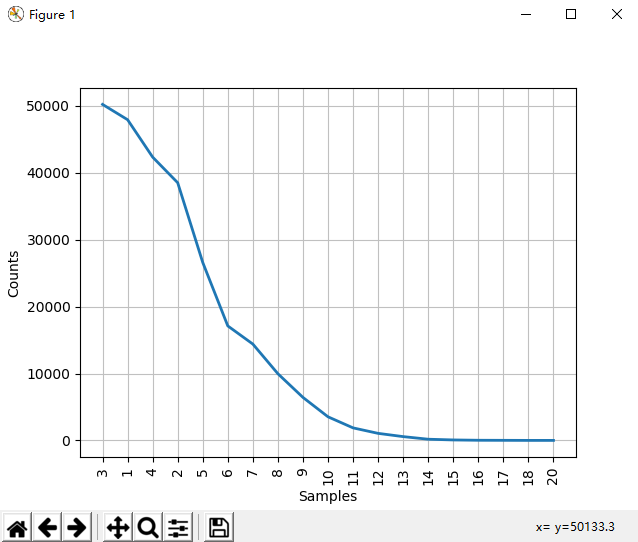
图1
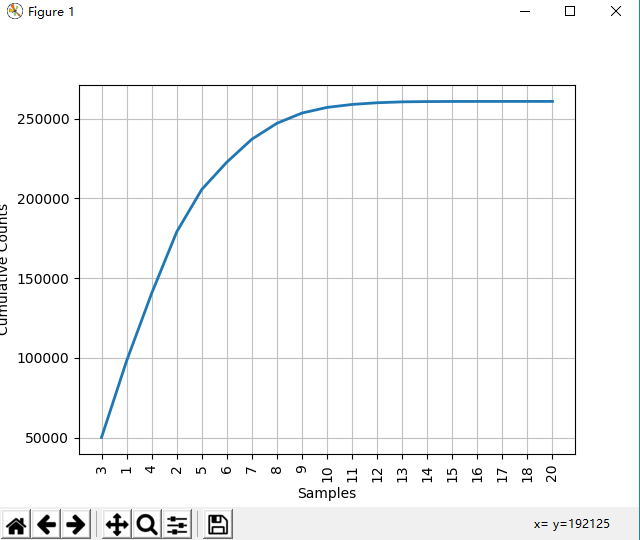
图2